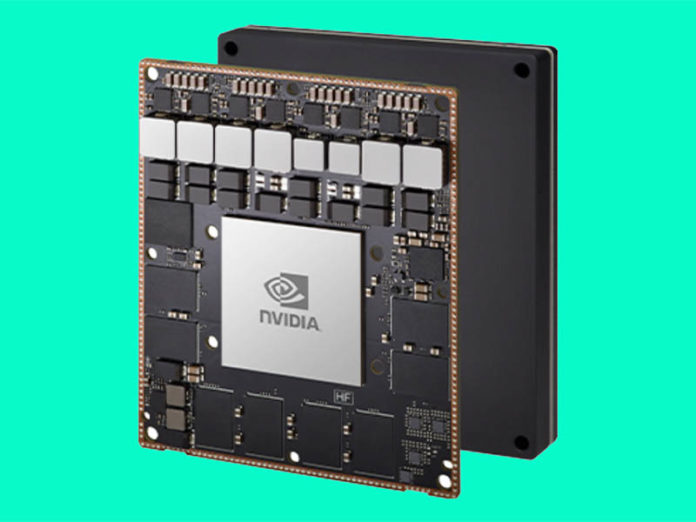A few weeks ago we reviewed the NVIDIA Jetson AGX Xavier powered Advantech MIC-730AI AI Edge Appliance. One of the key areas that we noted the video analytics platform was designed to work in is the industrial space. We even set up a demo of a textile inspection line using the Advantech unit to show an industrial application. Now, the NVIDIA Jetson AGX Xavier Industrial module is out.
NVIDIA Jetson AGX Xavier Industrial SOM
The Jetson AGX Xavier Industrial SOM is similar in many ways to the original AGX Xavier. There are a number of key differences as well. Here are the key specs with some of the big differences being bolded:
| NVIDIA Jetson AGX Xavier Industrial SOM Specs | |
| GPU | NVIDIA Volta architecture with 512 NVIDIA CUDA cores and 64 Tensor cores 20 TOPS (INT8) |
| CPU | 8-core NVIDIA Carmel Arm v8.2 64-bit CPU 8MB L2 + 4MB L3 |
| DL Accelerator | 2x NVDLA 10 TOPS (INT8) |
| Vision Accelerator | 2x 7-Way VLIW Vision Processor |
| Safety Cluster Engine | Dual Arm Cortex-R5 in lockstep |
| Memory | 32GB 256-bit LPDDR4x (ECC support) 136.5GB/s |
| Storage | 64GB eMMC 5.1 |
| CSI Camera | Up to 6 cameras (36 via virtual channels) 16 lanes MIPI CSI-2 D-PHY 1.2 (up to 40Gbps) C-PHY 1.1 (up to 62Gbps) |
| Video Encode | 2x 4K60 (H.265/H.264) 6x 4K30 (H.265/H.264) 12x 1080p60 (H.265/H.264) 24x 1080p30 (H.265/H.264) |
| Video Decode | 2x 8K30 (H.265) 4x 4K60 (H.265) 8x 4K30 (H.265) 18x 1080p60 (H.265) 36x 1080p30 (H.265) 24x 1080p30(H.264) |
| UPHY | 8x PCIe Gen4 3x USB 3.1 Single Lane UFS |
| Networking | 10/100/1000 BASE-T Ethernet |
| Display | Three multi-mode DP 1.2a/e DP 1.4/HDMI 2.0 a/b |
| Other I/O | USB 2.0 UART, SPI, CAN, I2C, I2S, DMIC & DSPK, GPIOs |
| Power | 20W | 40W |
| Mechanical | 100mm x 87mm 699 pin Molex Mirror Mezz Connector Integrated Thermal Transfer Plate |
While we gained ECC support, twice the eMMC, and the Safety Cluster Engine, the industrial module seems to have lost some GPU performance and increased power consumption. As an example of the performance loss, the INT8 TOPS are down as are some of the video encode/ decode capabilities.
In the industrial space, environmental temperature, shock, vibration, and other factors are very important. Here is a side-by-side comparison of the two:
| AGX Xavier | AGX Xavier Industrial | |
| Shock | Non-operational: 340G, 2 ms, half sine, 6 shocks/axis, 3 axes | Operational: 50G Half Sine 11 ms Non-operational: 140G, 2 ms, half sine, 3-axis, FCT/DPA, extend to 340G |
| Vibration | Non-operational: 10-500 Hz, 5G RMS, 8 hours/axis | Operational: 10-500 Hz, 5G RMS (random/sinusoidal) Non-operational: 10-1000 Hz, 3G RMS, 3-axis, FCT |
| Temperature | Operational: -25°C to 80°C at TTP | Operational: -40°C to 85°C at TTP |
| Humidity | Non-operational: 95% RH, -10°C to 65°C, 10cycl/240 hours | Non-operational: 95% RH, -10°C to 65°C |
| Operating Lifetime | 5 Years | 10 Years |
Here we can see that features such as the temperature ranges are wider than the non-industrial SOM. The new unit is also rated for a 10-year operating lifetime, or twice that of the original Jetson AGX Xavier.
Final Words
At first glance, the new industrial model looks very similar to the original AGX Xavier. When we started to look at the new module in more detail, there are quite a few areas of differentiation. We wish that NVIDIA used a naming scheme that made this clearer. NVIDIA is pushing into the industrial market as it offers a large number of devices that can transition to using AI inference bringing new capabilities.





The articles are getting shorter and shorter.